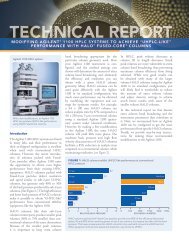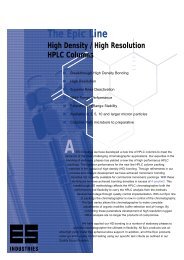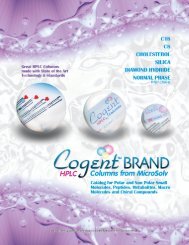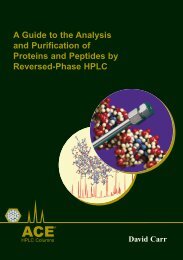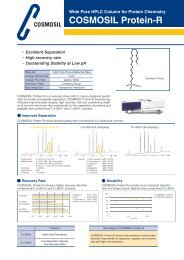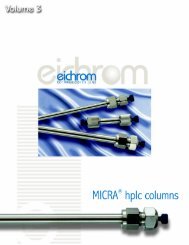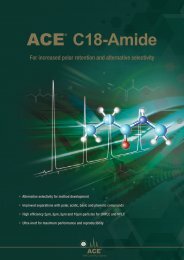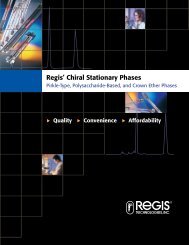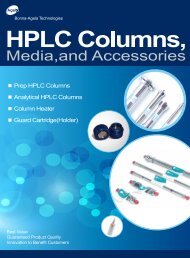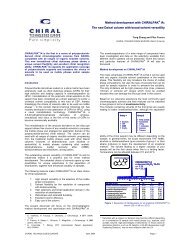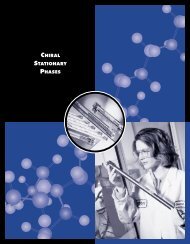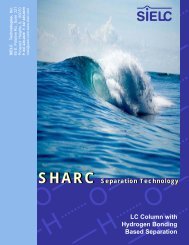Asahipak - Hplc.eu
Asahipak - Hplc.eu
Asahipak - Hplc.eu
- No tags were found...
You also want an ePaper? Increase the reach of your titles
YUMPU automatically turns print PDFs into web optimized ePapers that Google loves.
HPLC Separation ModesLiquid chromatography (LC) uses liquid as mobile phase (eluent). It is an analytical method that separates a mixture of compoundsbased on their physical and chemical differences. High-performance liquid chromatography (HPLC) is a method that introducesthe mobile phase under high-pressure conditions that results in rapid and high-performance separations. The various interactionsbetween the analyte, stationary phase (packing material), and mobile phase are the key factors for the separation. A wide varietyof separation mechanism can be obtained by using particular combinations of stationary and mobile phases.Separation modeCharacteristicsColumn selectionReversed PhaseChromatography(RPC)Normal PhaseChromatography(NPC)HydrophilicInteractionChromatography(HILIC)Ion ExchangeChromatography(IEC)HydrophobicInteractionChromatography(HIC)AffinityChromatography(AFC)Ligand ExchangeChromatography(LEX)Ion ExclusionChromatography(IEX)IonChromatography(IC)Size ExclusionChromatography(SEC)Chiral Separation(CS)MultimodeChromatography• Separation is based on the partition equilibrium between stationary phase and mobile phase.• The polarity of the stationary phase is lower than the mobile phase.• Typically used mobile phase contains a mixture of organic solvents (methanol, acetonitrile, or THF) and aqueous solvents(water or buffer).• Using the lower polarity mobile phase trigers a faster elution.• Separation is based on the partition equilibrium between the stationary phase and the mobile phase.• The polarity of the stationary phase is higher than that of the mobile phase.• Typically used mobile phase contains a mixture of organic solvents with different polarities such as hexane and isopropanol.• Using the higher polarity mobile phase trigers a faster elution.• Separation is based on hydrophilic interaction.• A high polarity stationary phase is used.• Typically the mobile phase contains a mixture of organic solvent such as acetonitrile and aqueous solvents (water or buffer).• Using the higher polarity mobile phase trigers a faster elution.• Applicable for the analysis of high polar substances.• Separation is based on electrostatic interactions between the ion exchanger and ionic solutes.• The mobile phase of choice should have a sufficient buffering capacity at the pH that produces the largest chargedifferences between the analyte of interest.• The elution position is optimized by varying the pH, salt concentration, and/or ionic strength of the mobile phase.• Separation is based on hydrophobic interaction.• Hydrophobic functional group is modified on the stationary phase.• Adsorption of analytes generally occurs at a high salt concentration and they are released by lowering the salt concentration.• Suitable for protein analysis.• Separation is based on adsorption of the analyte to the specific biologically derived ligand pair.• Highly selective.• A buffer solution with the appropriate pH and ionic strength is selected based on the type of ligand, analytes, and their interaction.• Mainly used for the purification and concentration of biological active substances.• Separation is based on differences in analytes’ coordination complex.• Stationary phase modified with metal sulfonate complex ion.• Works in the combination with size exclusion and HILIC modes.• Separation is based on electrostatic interaction (repulsion) between the ion exchanger and ionic solutes.• Dissociated ionic molecules elute faster than non-dissociated forms.• Used mainly for the analysis of inorganic compounds.• Separation is based on electrostatic interaction (bonding) between the ion exchanger and ionic solutes.• Has a relatively small ion exchange capacity.• Electrical conductivity detector can be used by employing a low-salt-concentration of mobile phase.• Used mainly for inorganic compound analysis.• The capillary pores on the surface of high-molecular-base gel works as molecular seve to separate molecules based ontheir sizes.• To separate molecules solely based on their sizes, it requires an analytical condition without any analyte and packinggel interaction.• The bigger the molecule size, the faster the elution sequence.• Suitable for molecular weight determination or molecular distribution of macromolecules and qualification of oligomers.• Separation of optical isomers using chiral selectors.• Highly selective.• Separation is based on the combination of different modes.3HPLC Separation ModesColumn selection by sample character and separation modeSamplesolubilityAqueoussolubleSampleMW≥ 2,000≤ 2,000SeparationmodeSECLEXIEXIECHICRPCAFCSECLEXIEXIECICRPCHILICAFCCSSamplesolubilityOrganicsolubleSampleMW≥ 2,000≤ 2,000SeparationmodeSECSECRPCNPCRPC : Reversed phase chromatographyNPC : Normal phase chromatographyHILIC : Hydrophilic interaction chromatographyIEC : Ion exchange chromatographyHIC : Hydrophobic interaction chromatographyAFC : Affinity chromatographyLEX : Ligand exchange chromatographyIEX : Ion exclusion chromatographyIC : Ion chromatographySEC : Size exclusion chromatographyCS : Chiral separation



